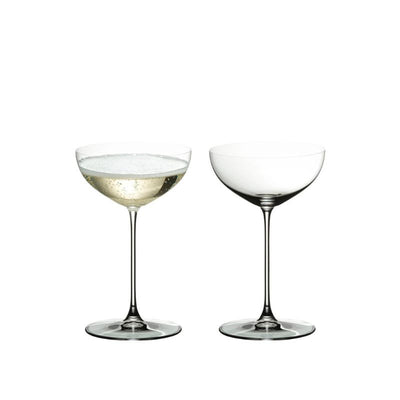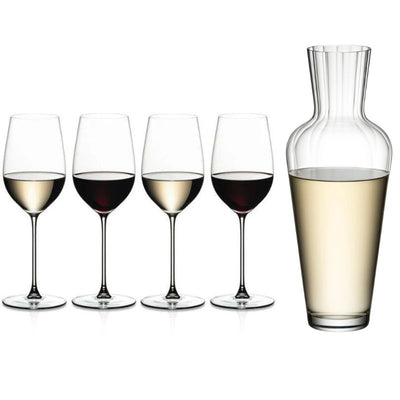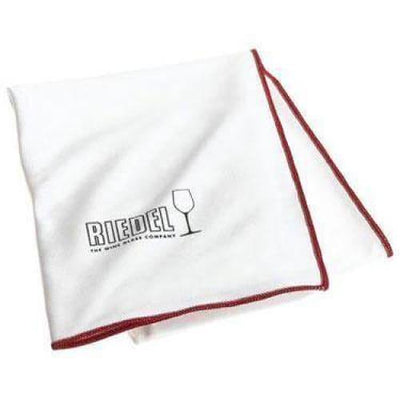Why Old World vs New World Wine Is Becoming Obsolete

I was chatting with a customer the other day about why some Riedel ranges have different shaped glasses for Old World and New World wines.
I trotted out the usual spiel: "Old World wines tend to be lighter-bodied, lower in alcohol, have brighter acidity, and show more earth-driven flavours. New World wines are usually fuller-bodied, higher in alcohol, have lower acidity, and are much riper on the palate. Or a bit more 'in your face!'"
It turned out that he had a Bordeaux that was 14.5% ABV - unheard of 30 years ago.
So this got me thinking about whether such broad brush strokes were still relevant - and frankly, whether they ever really were.
The Traditional Framework Falls Apart
Whether you're a wine novice or a seasoned enthusiast, you can't help but come across the terms "Old World" and "New World" when discussing or reading about wine. These terms are commonly used to describe wines based on their geographic origin and perceived style, but they provide an increasingly over-simplistic way to categorise the wider world of wine.
Traditionally, "Old World" wines refer to those from Western Europe, known for their lower alcohol levels and strong connection to the regions where the grapes are grown, or terroir.
This "broad brush" is already confusing. The traditional Old World countries are France, Italy, Spain, Germany and Portugal. However, the oldest winemaking equipment ever found was in Georgia, and the ancient Greeks certainly made plenty of wine.
Also, England is in Western Europe but is very much on the "New" side of the equation when it comes to winemaking - though that's rapidly changing as climate change transforms the UK into a serious wine-producing nation.
On the other hand, "New World" wines come from anywhere outside of Western Europe and are known for their fruit-forward flavours, attributed to modern winemaking techniques. Think of an "Old-World" farmer letting hand-picked grapes naturally ferment in an open-air field with nearby lambs, or in a cool Medieval cellar, while a "New-World" wine scientist in a white coat drops machine-harvested fruit into stainless steel vats jacketed by refrigeration units.

However, this Old vs. New World framework is becoming increasingly outdated in today's wine landscape. It oversimplifies the complexities of wine production and ignores how factors like climate change, technology, and global trends influence winemaking styles worldwide.
Climate Change Is Rewriting the Rules
Instead of focusing on Old vs. New, a more relevant approach would be to consider how climate change affects winemaking practices. Winemakers worldwide, including those in traditional wine regions, are adapting to warmer temperatures and changing conditions by incorporating new grape varieties and technology into their processes.
The most dramatic example comes from Bordeaux itself. In 2021, France's Ministry of Agriculture officially approved six new grape varieties for use in Bordeaux wines - four red varieties (Arinarnoa, Castets, Marselan, and Touriga Nacional) and two white varieties (Alvarinho and Liliorila). In the coming years, your venerable Bordeaux red might contain centuries-old varieties like Cabernet Sauvignon and Merlot, plus a dash of Arinarnoa, a cross between Tannat and Cabernet that was invented less than 70 years ago.
These new varieties are specifically chosen for their ability to handle hydric stress, late ripening characteristics, and resistance to diseases like grey rot and mildew. The varieties are limited to 5% of planted vineyard area and cannot account for more than 10% of a wine blend, but their introduction represents a seismic shift in thinking.
As the earth grows hotter and global technologies advance, winemakers everywhere - including in the so-called Old World - continue to grapple with earlier harvests, higher alcohol levels, and the need to embrace technology. If temperatures in Southern France climb above 38°C in September, winemakers there must use the climate-controlled storage and jacketed tanks historically associated with their "New World" brethren.
Basically, when you're using good science to make wine, that's "New World style" - regardless of where you are.
Consumer Preferences Drive Style, Not Geography
Consumer preferences play a significant role in shaping winemaking styles. Winemakers adjust their techniques to cater to evolving tastes and demand, regardless of geographic location.
Whether they're perfecting a red blend in a high-tech California winery or picking the same varieties their great-great-great-grandparents cultivated in a verdant French valley, most of them need to sell bottles to pay their bills.
Consequently, far-flung consumer tastes have affected winemaking styles for generations. In the 1980’s and 90’s, winemakers throughout the so-called Old World started making full-bodied, high-alcohol wines - regardless of historical precedent - because that style appealed to American wine critic Robert Parker and the deep-pocketed U.S. consumers who made purchases based on his reviews and recommendations.
Nowadays, many global wine drinkers prefer lighter, low-alcohol wines, so market-minded producers from Alsace to Zinfandel are changing their styles yet again to appeal to them. Two-thirds of regular wine drinkers in the biggest markets describe sustainability as important to them, reaching as high as 70% in the US and 94% in China.
Geography isn't driving those stylistic changes as much as the need to find a market and stay in business.
A Better Framework: Farming vs. Industrial
This underscores the need to move beyond geographic labels and focus on how wines are made, whether through traditional farming methods or industrial processes.
Severine Schlumberger, whose family have owned the "Domaines Schlumberger" vineyards in Alsace since 1810, suggests replacing the Old vs. New World framework with a classification based on farming practices versus industrial methods. This approach emphasises how winemaking techniques impact wine quality and ageing potential, rather than where the wine originates.
She compares agricultural wine to locally grown fruits and vegetables you might find at a farm stand, whereas industrial wine is akin to bananas flown from massive commodity farms to chain supermarkets.
The wine industry is experiencing a surge in regenerative viticulture, which focuses on outcome-based improvements to soil health rather than rules-based restrictions. Sustainability has become a central concern for both consumers and producers, with more individuals prioritizing brands that align with their environmental values.
The New Reality: Technology and Terroir
The distinction between traditional and modern winemaking has become fluid. Technology, including satellite imagery, AI, and GIS, is crucial for precise vineyard monitoring, resource management, and decision-making, helping vintners optimize production, manage climate risks, and improve sustainability.
Even in the most traditional regions, winemakers are embracing precision viticulture with drones and AI, blockchain tracking of wine provenance, and sophisticated climate monitoring systems. Meanwhile, many "New World" producers are returning to more traditional methods like natural fermentation and minimal intervention.
Co-fermentation techniques are gaining traction, where winemakers blend different types of fruits together to create unique flavour profiles - appealing for their experimental nature and ability to create wines that reflect non-European and non-mainstream traditions.
Creating Inclusive Dialogue
While abandoning the Old vs. New World classification may seem daunting, it opens up opportunities for inclusive dialogue and innovation in the wine world. Regina Jones Jackson, owner of Corks and Cuvée in Conyers, Georgia, believes in creating new terminology that welcomes everyone into the world of wine, fostering a more inclusive and welcoming community.
"I can see the fear I strike in people when I use the term 'Old World,'" she says. "People tend to shy away, they think, 'Oh, here we go, this is gonna be over my head.'"
The Academic Perspective
Dr. D. Christopher Taylor at the University of Houston's Conrad N. Hilton College of Global Hospitality Leadership uses Old World vs. New World terms as more of a historical touchpoint than a modern-day classification system. "The notion of being able to describe wine style in terms of Old World versus New World is not relevant in today's wine marketplace. Especially for new wine consumers... it's obsolete as a good descriptor to demarcate one style of wine from another."
European Snobbery vs. Reality
There is, in Europe, more than a little bit of snobbery when it comes to the qualities of New World wines. Indeed, plenty of wine drinkers avoid Australian and American wines completely, having the attitude that they'll never be as fine or refined as the time-honoured wines of Europe.
However, plenty of blind tastings have resulted in many red faces among the European wine elite. Including an English sparkling wine beating Champagne, in Champagne! Time and time again, wine experts and tasters have preferred Australian and Californian wines at blind tastings, which goes to show how ridiculous it is to approach wine with any sort of prejudice.
If it's made with love and passion, respect and dedication to excellence, fine wine can hail from almost any corner of the planet.
The Future Is About Values, Not Geography
As consumers become more knowledgeable about wine, they prioritize quality, transparency, and ethical production practices when making their selections. The wine industry is seeing increasing adoption of sustainable practices and cultivation techniques, including organics, biodynamics and regenerative viticulture, as well as adaptive changes such as planting alternative grape varieties and exploration of cooler, high-altitude or coastal regions.
What matters now isn't whether a wine comes from the "Old World" or "New World," but whether it's made with:
- Sustainable practices that respect the environment
- Quality farming that focuses on soil health and biodiversity
- Transparency about production methods and ingredients
- Adaptation to changing climate conditions
- Innovation that maintains tradition while embracing necessary change
Moving Forward
To paraphrase Pablo Picasso, "The only reason to learn the rules is so you can break them later."
The Old World vs. New World framework served its purpose in helping us understand wine history and development. But in 2025, with Bordeaux adding Portuguese grapes, English sparkling wines winning international acclaim, and regenerative viticulture spreading from California to Champagne, these categories have become meaningless.
The traditional binary classification of wines into "Old World" and "New World" is increasingly seen as overly simplistic in today's complex global wine landscape. While these terms were initially helpful in distinguishing between two primary styles of winemaking, they don't adequately capture the diversity and nuance present in modern winemaking.
In the end, embracing change and evolution is essential for the continued growth and sustainability of the wine industry. Rather than clinging to outdated labels, let's focus on building a future where wine appreciation is accessible to all.
Climate change, consumer preferences, and technological advancement are the real forces shaping wine today. The sooner we move beyond geographical prejudices and focus on quality, sustainability, and innovation, the better off we'll all be.
Whether your wine comes from a 1,000-year-old vineyard in Burgundy or a brand-new plot in Tasmania, what matters is whether it's delicious, well-made, and represents the best of what that place and that winemaker can achieve.
Now that's a classification system I can raise a glass to!











Leave a comment